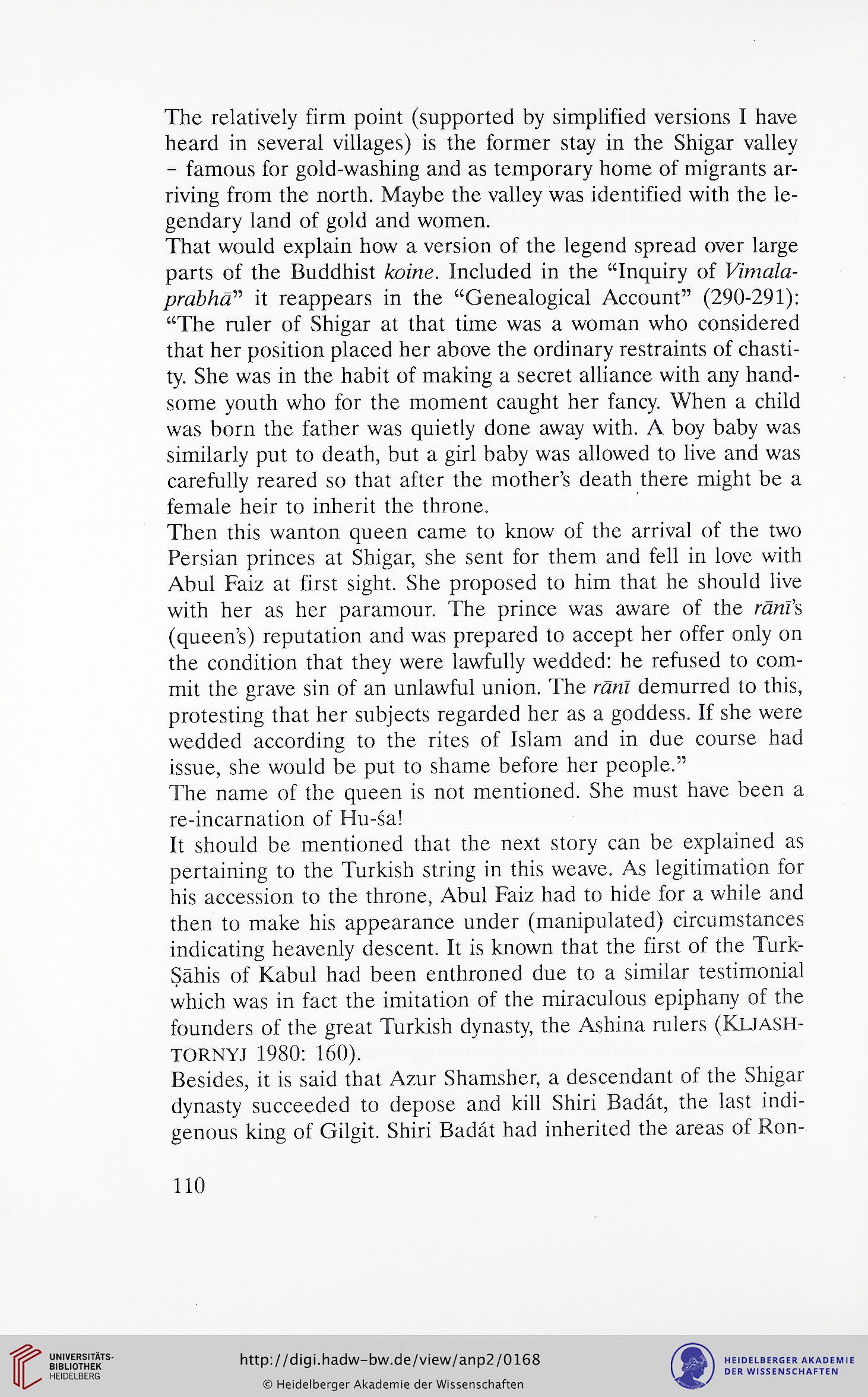The relatively firm point (supported by simplified versions I have
heard in several villages) is the former stay in the Shigar valley
- famous for gold-washing and as temporary home of migrants ar-
riving from the north. Maybe the valley was identified with the le-
gendary land of gold and women.
That would explain how a version of the legend spread over large
parts of the Buddhist kome. Included in the "Inquiry of Fwm/a-
pmb/m" it reappears in the "Genealogical Account" (290-291):
"The ruler of Shigar at that time was a woman who considered
that her position placed her above the ordinary restraints of chasti-
ty. She was in the habit of making a secret alliance with any hand-
some youth who for the moment caught her fancy. When a child
was born the father was quietly done away with. A boy baby was
similarly put to death, but a girl baby was allowed to live and was
carefully reared so that after the mother's death there might be a
female heir to inherit the throne.
Then this wanton queen came to know of the arrival of the two
Persian princes at Shigar, she sent for them and fell in love with
Abul Faiz at first sight. She proposed to him that he should live
with her as her paramour. The prince was aware of the mm's
(queen's) reputation and was prepared to accept her offer only on
the condition that they were lawfully wedded: he refused to com-
mit the grave sin of an unlawful union. The mm demurred to this,
protesting that her subjects regarded her as a goddess. If she were
wedded according to the rites of Islam and in due course had
issue, she would be put to shame before her people."
The name of the queen is not mentioned. She must have been a
re-incarnation of Hu-sa!
It should be mentioned that the next story can be explained as
pertaining to the Turkish string in this weave. As legitimation for
his accession to the throne, Abul Faiz had to hide for a while and
then to make his appearance under (manipulated) circumstances
indicating heavenly descent. It is known that the first of the Turk-
Sähis of Kabul had been enthroned due to a similar testimonial
which was in fact the imitation of the miraculous epiphany of the
founders of the great Turkish dynasty, the Ashina rulers (KUASH-
TORNYJ 1980: 160).
Besides, it is said that Azur Shamsher, a descendant of the Shigar
dynasty succeeded to depose and kill Shiri Badât, the last indi-
genous king of Gilgit. Shiri Badât had inherited the areas of Ron-
110
heard in several villages) is the former stay in the Shigar valley
- famous for gold-washing and as temporary home of migrants ar-
riving from the north. Maybe the valley was identified with the le-
gendary land of gold and women.
That would explain how a version of the legend spread over large
parts of the Buddhist kome. Included in the "Inquiry of Fwm/a-
pmb/m" it reappears in the "Genealogical Account" (290-291):
"The ruler of Shigar at that time was a woman who considered
that her position placed her above the ordinary restraints of chasti-
ty. She was in the habit of making a secret alliance with any hand-
some youth who for the moment caught her fancy. When a child
was born the father was quietly done away with. A boy baby was
similarly put to death, but a girl baby was allowed to live and was
carefully reared so that after the mother's death there might be a
female heir to inherit the throne.
Then this wanton queen came to know of the arrival of the two
Persian princes at Shigar, she sent for them and fell in love with
Abul Faiz at first sight. She proposed to him that he should live
with her as her paramour. The prince was aware of the mm's
(queen's) reputation and was prepared to accept her offer only on
the condition that they were lawfully wedded: he refused to com-
mit the grave sin of an unlawful union. The mm demurred to this,
protesting that her subjects regarded her as a goddess. If she were
wedded according to the rites of Islam and in due course had
issue, she would be put to shame before her people."
The name of the queen is not mentioned. She must have been a
re-incarnation of Hu-sa!
It should be mentioned that the next story can be explained as
pertaining to the Turkish string in this weave. As legitimation for
his accession to the throne, Abul Faiz had to hide for a while and
then to make his appearance under (manipulated) circumstances
indicating heavenly descent. It is known that the first of the Turk-
Sähis of Kabul had been enthroned due to a similar testimonial
which was in fact the imitation of the miraculous epiphany of the
founders of the great Turkish dynasty, the Ashina rulers (KUASH-
TORNYJ 1980: 160).
Besides, it is said that Azur Shamsher, a descendant of the Shigar
dynasty succeeded to depose and kill Shiri Badât, the last indi-
genous king of Gilgit. Shiri Badât had inherited the areas of Ron-
110




